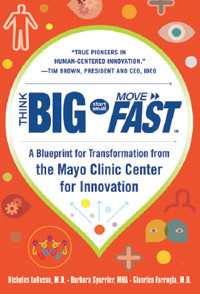
Think Big, Start Small, Move Fast: A Blueprint for Transformation from the Mayo Clinic Center for Innovation
Nicholas LaRusso, Barbara Spurrier, & Gianco Farrugia
263 pages, McGraw-Hill, 2014
Does innovation have to be disruptive? Over the past decade, Clayton Christensen’s disruption theory has become so prevalent that undergraduates at the University of Southern California can practically major in it. (The USC Jimmy Iovine and Andre Young Academy, which enrolled its first students this year, markets itself as offering “a degree in disruption.”) Christensen’s theory, introduced in 1995, favors disruptive innovation, which redefines a market, over sustaining innovation, which delivers incremental improvements. Companies that focus only on sustaining innovation, Christensen has argued, run the risk of being made irrelevant by disruptive competitors.
More recently, the disruption imperative— “disrupt or die”—has seen a robust backlash. Jill Lepore’s scathing critique of Christensen’s theory in the New Yorker last July is one example. Now, in Think Big, Start Small, Move Fast, three professionals from the Mayo Clinic take an implicitly skeptical approach to disruption theory. Nicholas LaRusso, Barbara Spurrier, and Gianrico Farrugia, all of whom are founding members of the Center for Innovation (CFI) at Mayo, use their book to discuss sustaining innovation—or, as it’s sometimes known, “transformational” innovation—in health care. “Transformational innovation is an evolutionary form of innovation built on an undivided focus on the customer and customer experience,” they write.
The key word here is “evolutionary.” The authors of Think Big are quick to acknowledge the relatively modest ambitions of their brand of innovation. “Is our Pediatric Phlebotomy Chair a disruptive innovation? … Probably not,” they write. “Although it did transform a patient experience, it’s hardly a game changer—and really, that’s by design. Tearing down everything and starting over is not an option in health care.” The conceit that disruptive change is “not an option” will set off alarm bells in the minds of disruption theory purists. (In Christensen’s model, an industry in which people view innovation in that way is ripe for disruption.) For other readers, though, the book offers an invitation to cultivate non-disruptive innovation—not because the theory of disruption is bankrupt, but because sustaining innovation is a necessary and valid endeavor in its own right.
The Mayo Clinic, founded in Rochester, Minn., in 1887, grew out of a partnership between providers and administrators. That commitment to interdisciplinary collaboration, along with the team approach adopted by clinic founder W. W. Mayo and his sons, continues to define the institution’s culture. Early medical innovations attributable to Mayo, such as the common medical record and the tumor-grading index, exemplify its highly pragmatic ethos. In the words of John Noseworthy, the clinic’s current president and CEO, “the practice is the main thing.”
Before the creation of CFI in 2008, innovation at Mayo occurred primarily within its research arm, a $630 million operation that publishes 4,000 studies per year. LaRusso, then chair of the Department of Medicine, initiated CFI as a patient-centered group that would focus not on generating medical research, but on improving care delivery. Noting the steps that other service-oriented industries had taken to enable innovation, the CFI team began collaborating with IDEO and other design firms to incorporate “design thinking” into its work. Design thinking starts from empathy for the needs of the user, and seeks to meet those needs creatively within the confines of a given organization.
Think Big is at its best when the authors describe specific innovations that CFI has delivered. The Smart Mirror, for example, incorporates an electronic display and mobile phone connection into an everyday object. It’s used to collect medical data from seniors and to deliver reminders to them. The prototype was developed at Mayo’s Healthy Aging and Independent Living Lab, a simulated senior living environment located inside a retirement community. Developing both of these innovations—the mirror and the lab—entailed a willingness to prioritize the needs and expectations of consumers over more traditional medical service considerations. This approach represents a significant departure for an organization like the Mayo Clinic. Mayo has traditionally followed a “medical practice” model that treats the patient as a passive recipient of provider services. CFI’s use of design thinking renders the patient an active user and promotes medical consumerism.
Think Big reads like an introductory-level textbook. It’s collegial and approachable, but theoretical jargon and marketing buzzwords weigh down what would otherwise be fresh concepts and at times obfuscate the authors’ message. A paragraph on “acceptance of the normalization of deviance,” for example, needlessly and erroneously introduces critical theory to make the simple point that mediocre performance has become acceptable within health care. (Mediocrity is, by definition, normal rather than deviant.)
Overall, though, Think Big offers a refreshingly practical look at innovation in the health sector, as seen through the lens of an institution that has brought design thinking to patient care. It celebrates incremental improvements and a willingness to “start small” within complex systems. Design thinkers will appreciate the application of those principles to an environment that is starving for such an approach. Die-hard disruptors will need to look elsewhere.

